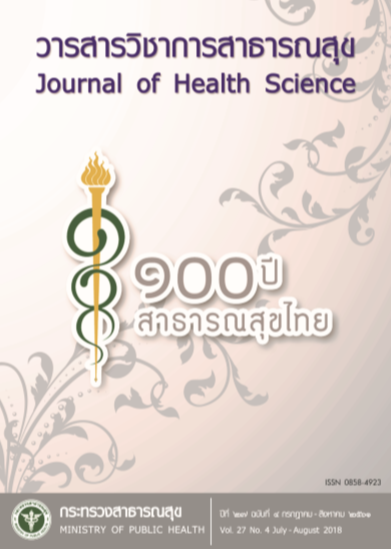Parenteral Nutrition-Associated Cholestasis in Neonates Which Birth Weight Under 2,500 Grams
Keywords:
parenteral nutrition, parenteral nutrition-associated cholestasis, non-protein calories:nitrogen ratioAbstract
Parenteral nutrition (PN) in neonate may induce parenteral nutrition-associated cholestasis (PNAC), a common complication in infants of which the etiology is multifactorial. The most important factor was nutrients especially non-protein calories:nitrogen (NPcal:N) ratio. Previous studies are very few and no studies have been conducted to identify the optimal NPcal:N ratio to reduce the incidence of PNAC. The objective of this research was to study the association of NPcal:N ratio and the development of PNAC in neonate. It was conducted as a retrospective cohort study in infants who were admitted to neonatal intensive care unit (NICU) at Nakornping Hospital. The samples were infants weighing less than 2,500 g and recieved PN infusion for at least 14 days during the years 2009 to 2016. Data were collected from medical records for 26 risk factors. Patients were divided in two groups, with and without PNAC. PNAC was defined as a serum total bilirubin (TB) >2.0 mg/dL, with a serum direct bilirubin (DB) >20.0% of the TB during the PN. Data were analyzed on the differences in risk factors between groups by using univariate analysis; and selected significant risk factors (p<0.05) were further analyzed by backward multivariable logistic regression and receiver operating characteristic curve (ROC curve) to predict PNAC. Altogether 975 infants receiving PN were enrolled; 278 infants were eligible for this study; and 92 (9.44 %) of them developed PNAC. Univariable analysis revealed that gender, apgar score at 1 minute, sepsis, bron-chopulmonary dysplasia, necrotizing enterocolitis, PN duration, enteral nutrition(EN) started date, total amino acid (AA) intake, total energy intake from AA, total lipid intake, glucose infusion rate, nonprotein calories intake, total energy intake and NPCal: N> 125:1 were significantly different between the 2 groups. Backward multivariable logistic regression analysis found that NPCal:N ratio more than 125:1 (OR =1.923; CI 1.073-3.446), prolonged PN duration >14 days (OR =1.077; CI 1.041-1.115) and delayed EN start dated >5 day after birth (OR=1.100; CI 1.023-1.183) were significantly associated with the development of PNAC; and the receiver operating characteristic (ROC) curve analysis of these factors could predict the development of PNAC up to 71.4%. Thus, this study results could be used as a monitoring guideline to reduce the development of PNAC by keeping NPCal:N ratio ‹ 125:1 with early start of EN within 4 days after birth, and provide PN duration infusion for less than 14 days. However, monitoring of many other factors associated with the development of PNAC may also be needed.
Downloads
Downloads
Published
How to Cite
Issue
Section
License
Copyright (c) 2018 Journal of Health Science- วารสารวิชาการสาธารณสุข

This work is licensed under a Creative Commons Attribution-NonCommercial-NoDerivatives 4.0 International License.







